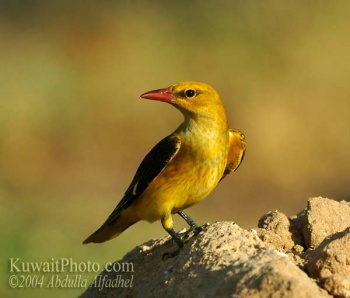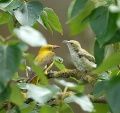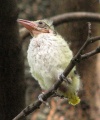- Oriolus oriolus
Identification
24cm
- Dark grey legs
- Red eye
- Fairly thick pinkish bill
Male
Bright yellow with black wings and tail.
Female and Juvenile are yellowy-green, with paler underparts; wings and tail are darker.
Similar Species
The female and juvenile can be confused with Green Woodpecker with poor flight views. However the woodpecker's flight is markedly undulating.
Distribution
Western Palearctic to eastern Siberia; winters to Africa and north-western India.
Taxonomy
This is a monotypic species[1].
Indian Golden Oriole was split from this species.
Habitat
Always near or in trees, particularly holm oak. Well-timbered parks, gardens and orchards and trees beside lakes and rivers.
Behaviour
Breeding
The nest is built in a fork in a tree; 3-6 eggs are laid.
Diet
The diet includes insects and fruit.
Vocalisation
Gallery
Juvenile with adult
Photo by d.flack
RSPB Lakenheath Fen, Suffolk, July 2007Chick
Photo by Cristian Mihai
Bucharest, Romania, June 2007
References
- Clements, J. F., T. S. Schulenberg, M. J. Iliff, B.L. Sullivan, C. L. Wood, and D. Roberson. 2012. The eBird/Clements Checklist of Birds of the World. 6th ed., with updates to October 2012. Ithaca: Cornell Univ. Press. ISBN 978-0801445019. Spreadsheet available at http://www.birds.cornell.edu/clementschecklist/downloadable-clements-checklist
- Birdwatchers Pocket Guide ISBN 1-85732-804-3
- Collins Field Guide 5th Edition
- Wikipedia
Recommended Citation
- BirdForum Opus contributors. (2025) Eurasian Golden Oriole. In: BirdForum, the forum for wild birds and birding. Retrieved 11 May 2025 from https://www.birdforum.net/opus/Eurasian_Golden_Oriole
External Links
GSearch checked for 2020 platform.








